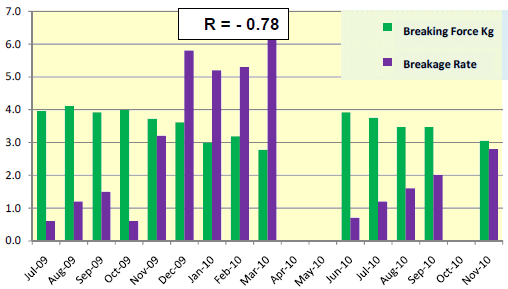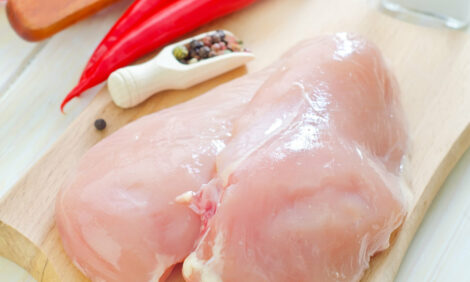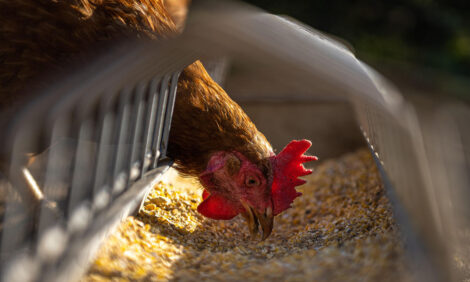



Summary Report of Egg Shell Breaking Force Observations in 2010
An evaluation of the egg breaking force of two groups of egg-laying hens, Hy-Line and Lohmann, throughout the flocks' lifecycle was carried out by Hagit Arazi, SHAHAM (Ministry of Agriculture, Israel), Yael Kellner and Gan Haim.Introduction
Inferior egg shell quality is one of the main reasons causing losses to producers.
Research conducted in the recent past has helped to evaluate the relationship between egg shell characteristics and specific breeds of layers. The observation involves a review of shell quality and the changes it undergoes throughout the hen's lifecycle as measured by the shell's breaking force.
It has been assumed that if any correlation is found between the breaking force and the number of broken egg shells, the level of deterioration of the shell quality – as measured by the breaking force, as an additional parameter in determining the marketing age of the flock – can be determined.
Experiment Protocol
The observation was held at Kalner Farm located in Gan Haim, Israel.
 |
The observation covered two groups of egg-laying hens, which were grown in the same farm but in separate hen-houses:
- Lohmann hens, hatched on 3 December 2008
- Hy-Line hens, hatched on 1 December 2008
The observation involved an evaluation of egg shells that were seemingly whole with an instrument used to measure the shell breaking force.
The experiment was held in collaboration with Orka Food Technology Ltd, an Israeli company, which provided Egg Tester with the following shell strength gauges:
- Egg Analyzer™: an automatic egg quality tester measuring the weight, albumen height, yolk color and Haugh unit in 17 seconds (patent pending)
- Egg Force Reader: an instrument which measures the weight in kg necessary to break an egg shell.
Summary of Results (to November 2010)
| Table 1. Eggshell breakage rate in Hy-Line and Lohmann egg-laying hens throughout the observation term | ||||
| Date | Break force in Kg | Eggshell breakage rate per henhouse | ||
|---|---|---|---|---|
| Hy-Line | Lohmann | Hy-Line | Lohmann | |
| July 09 | 3.96 | 4.36 | 0.6 | 0.4 |
| August 09 | 4.11 | 4.33 | 1.2 | 0.5 |
| September 09 | 3.92 | 4.17 | 1.5 | 1.6 |
| October 09 | 3.99 | 4.25 | 0.6 | 1.0 |
| November 09 | 3.72 | 4.37 | 3.2 | 1.5 |
| December 09 | 3.61 | 3.99 | 5.8 | 2.2 |
| January 10 | 2.99 | 3.61 | 5.2 | 1.3 |
| February 10 | 3.19 | 3.75 | 5.3 | 1.9 |
| March 10 | 2.77 | 3.12 | 6.5 | 3.7 |
| June 10 | 3.92 | 3.82 | 0.7 | 1.4 |
| July 10 | 3.75 | 3.77 | 1.2 | 1.5 |
| August 10 | 3.47 | 3.70 | 1.6 | 1.6 |
| September 10 | 3.46 | 3.48 | 2.0 | 2.1 |
| November 10 | 3.04 | 3.35 | 2.8 | 3.3 |

The chart and table above show there is variation in the breaking force index between Lohmann and Hy-Line breeds throughout the observation period.
Eggshell strength was higher in Lohmann hens than in the Hy-Line breed. This difference is also reflected in the eggshell breakage rate in the henhouse (see above).
During the first egg-laying season, there was a significant difference between the breeds.
Moulting significantly improved the eggshell force in both groups, minimising the gap between the Lohmann and Hy-Line breeds. During the first few months after the moulting, the breakage rate in the hen houses transformed, with a higher breakage rate for the Lohmann eggs than the Hy-Line eggs.

Figure 2 illustrates the inverted correlation between the breaking force and the breakage rate in Hy-Line hens. The higher the breaking force, namely the more force needs to be exerted on the egg shell to break it, the lower the breakage rate in Hy-Line hens. In other words, there is a correlation between the breaking force index and the hen house's breakage rate (R=0.78).

Figure 3 above illustrates the inverted correlation between the breaking force and the breakage rate in Lohmann hens. The higher the breaking force, the lower the breakage rate in Lohmann hens. The correlation between the breaking force index and the hen house's breakage rate is R=0.82.
Discussion
The results obtained lead to the following conclusions:
- Correlation between breaking force index and breakage rate was found in both hen houses.
- During the first egg-laying period, the breaking force in Hy-Line hens was found to be lower with higher breakage rate. This has led to the conclusion that the shells of Hy-Line eggs are weaker than the shells of Lohmann eggs.
- The breaking force and the breakage rate in both hen houses improved in the first few months after moulting.
- The breakage rate gap between Hy-Line and Lohmann in the first period is gone and even reversed, with breakage rate in Lohmann hens exceeding that of Hy-Line hens.
The observations were summarised with detailed discussion of the results in March 2011, at the end of the flock's lifecycle, and resent to the Council.
June 2011







